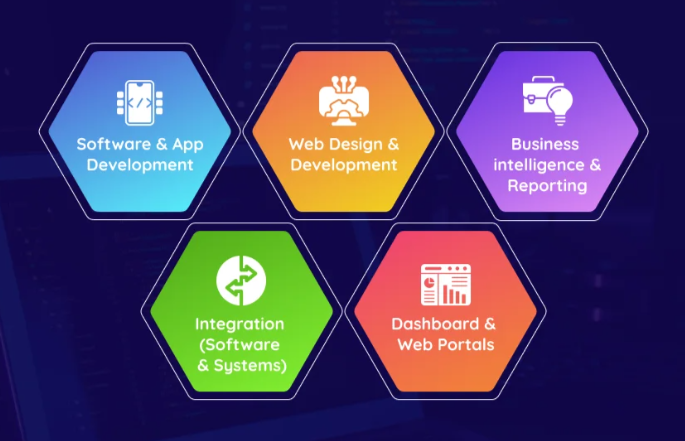For effective business analysis, companies must decide between internal and external software development. This choice has become critical as businesses aim to stay competitive in today's rapidly changing landscape. Our comprehensive guide explores the debate between hiring in-house talent or external experts. By comparing the pros and cons of each approach, we help you make the right decision based on your specific needs.
Developing business analysis software internally allows for greater control and customisation aligned with your organization. Fostering in-house skills also cultivates deeper expertise within your company. However, internal development requires substantial investment in training and infrastructure. The costs of maintaining and upgrading software can be high as well.
Alternatively, external software development provides immediate access to specialised skills without recruiting. Partnerships with vendors allow you to scale up or down flexibly to meet project needs. However, relying on external teams means less control over the process, which some businesses find risky. Communication and coordination with outsiders brings challenges too.
When deciding between internal vs external software development for business analysis, comparing costs is essential. Internal options appear cheaper initially but can lead to unexpected expenses long-term. External developers' experience can streamline processes and ultimately save time and money.
It's also crucial to evaluate required expertise and resources. Internal teams enable better collaboration and industry knowledge, but limit skill sets. External partners offer diverse skills yet need aligned goals. Careful vetting is key.
Additionally, project management factors into the decision heavily. Internal development allows more control and customisation. External teams bring increased speed and efficiency. Clear communication and milestones are essential to keep external partners on track.
By weighing all of these considerations around internal vs. external software development, businesses can make the optimal choice for their business analysis needs and stay competitive. Assess your costs, resources, and project management needs for success.
Pros and Cons of Internal Software Development for Business Analysis

When examining the pros and cons of internal software development for business analysis, companies weigh several key factors. Opting to build analysis software in-house allows greater control and customisation tailored to your specific needs. Internal development also enables nurturing talent and expertise within your organisation around its unique requirements. However, pursuing internal software development is not without downsides.
The benefits of internally built business analysis software include the ability to completely align the system with your company's processes, workflows, and objectives. You can customise the software to your industry, business model, and data ecosystem. Internal development also facilitates cultivating specialised analytical skills within your existing team. Your developers gain deeper insights into your organisational needs through direct collaboration.
However, internal software development also requires extensive investments in training, infrastructure, and other resources. The costs involved make it important to ensure the benefits outweigh the expenses. Internal development can be time-intensive compared to external software solutions. Maintaining and upgrading the system also carries substantial ongoing costs as technology evolves rapidly.
In summary, key pros of internal business analysis software include greater customisation, control, and ability to build in-house expertise. But the cons like time commitments, infrastructure needs, and maintenance costs must also factor into the decision. Carefully weighing these trade-offs allows an informed choice aligning with long-term goals and maximising value. The right software solution provides impactful data insights while optimising resource utilization. Evaluating the full range of pros and cons is imperative to make the best business decision for your organisation's analysis needs.
Advantages and Disadvantages of External Software Development for Business Analysis

When examining the advantages and disadvantages of external software development for business analysis, multiple factors emerge. Partnering with an external developer provides access to diverse talent beyond one's in-house team. This outside expertise facilitates innovative solutions and fresh perspectives to help companies stay competitive. External partners also enable efficient scaling of resources up or down based on changing project needs. Avoiding costs of hiring and training permanent staff is a plus. However, disadvantages like communication challenges and lack of control over the process also require evaluation when weighing external development.
A major benefit of outsourcing business analysis software development is tapping into a wide talent pool with specialised skills. External developers bring expertise likely missing internally, spurring new insights and creativity. The agility of external partnerships allows adjusting resources quickly according to analysis needs instead of carrying unnecessary staff. But communication and coordination with outside providers can be difficult, causing delays or confusion. Relying on external developers also means less control over the process, which some businesses find risky.
In summary, key advantages of external software development for business analysis include accessing high-level expertise, increased agility, and avoiding hiring/training costs. But disadvantages like communication gaps and lack of control should also factor into the decision. Evaluating budget, needs, and internal capabilities is essential to determine if external partners make sense. Their experience can enhance quality and efficiency. But loss of control can be concerning for businesses with strict requirements. Weighing all pros and cons allows an informed decision that matches business analysis goals. The right software solution balances outside expertise with internal integration. Careful comparison of all trade-offs drives optimal investment and success.
Factors to Consider When Deciding Between Internal and External Software Development for Business Analysis

Several critical factors must be evaluated when deciding between internal and external software development for business analysis. Assessing time requirements is essential, as internal development often requires more time to build expertise and complete projects. However, external partners typically have specialised knowledge to expedite processes. Evaluating costs is also imperative. Internal options seem cheaper initially but can lead to hidden expenses. External developers may have higher upfront costs but streamline development to save money long-term.
When weighing internal versus external software development, analyse the time investment required thoroughly. Building skills internally takes substantial time. But experienced external partners can deliver results faster by leveraging established expertise. Developing software internally also risks unforeseen delays from training and adjustments. Still, closer coordination with internal teams can potentially accelerate some processes through better communication.
Additionally, compare costs projections carefully. Internal development appears more affordable at first. But unexpected expenses from issues or training often emerge. While external providers have higher initial price tags, their experience creates efficiencies that save time and money in the long run.
In summary, deciding between internal and external business analysis software development requires analysing key factors like time and costs. While internal options seem quicker and cheaper at first glance, deeper analysis of productivity and expenses may reveal external partnerships as the faster, more cost-effective choice. Weighing all pros and cons allows an informed decision tailored to your specific organisational needs and resources. The right software solution integrates outside experience with internal collaboration for maximum business insight. Evaluating all aspects drives optimal investment and success.
Evaluating the Costs of Internal vs. External

When evaluating the costs of internal versus external software development for business analysis, comparing short and long-term cost implications is essential. Internally developed software offers greater control and customisation but requires substantial investments in skilled talent, infrastructure, and ongoing maintenance. External development provides immediate access to expertise and established processes but has higher upfront costs.
Opting for in-house software development may appear cheaper initially. But it necessitates considerable expenses for hiring and training developers, sustaining technical infrastructure, and providing continual support. As technology evolves rapidly, upgrading internally built systems gets increasingly expensive over time.
Alternatively, external development costs more upfront but offers specialised skills without recruiting expenses. Vendor partnerships also leverage proven processes and best practices to optimise productivity and quality. Though managing an internal team seems avoided, vendor contracts still require oversight.
Additionally, external developers stay current on emerging technologies to build cutting-edge, scalable solutions. But careful vetting is crucial to pick partners that meet business objectives and deliver high-quality products.
In summary, evaluating costs of internal versus external business analysis software requires analyzing both short and long-term factors. While internal options look cheaper upfront, they carry hidden costs over time. External partners have higher initial price tags but frequently save money through efficiencies long-term. Comparing total cost implications allows informed decisions tailored to organisational goals, resources, and needs. The right software maximises value by balancing internal control with outside expertise.
Project Management Considerations for Internal vs. External Software Development for Business Analysis

When selecting business analysis software, evaluating required expertise and resources is critical for both internal and external options. Internally developed solutions allow close collaboration and in-depth knowledge of company operations. But internal projects demand extensive skilled personnel, infrastructure, and time investments. Externally developed software provides immediate access to specialised expertise and resources. However, careful partner evaluation is essential to ensure alignment with goals and deliverables.
In-house development enables tailoring software specifically to business needs and workflows due to intimate operational knowledge. Internal teams fully understand requirements and can work closely together for optimal results. But developing internally requires devoting substantial resources to hire and train skilled developers, provide needed tools and systems, and manage extended development timelines.
Alternatively, external partners offer pre-existing expertise to accelerate development and enhance quality. Outsourcing can minimise costs associated with permanent specialised staff and infrastructure. However, external providers still require oversight to guarantee software aligns with internal needs rather than vendor biases. Ensuring partners have proven track records and shared values is key.
In summary, both internal and external options have pros and cons when evaluating required expertise and resources for business analysis software. Internal development allows better customization but demands more investment. External partners provide immediate access to knowledge at the risk of misalignment. Weighing all factors helps make the optimal choice to match organisational goals and resources. The right software balances internal insights with outside experience for maximum value.
Project Management Considerations for Internal vs. External

When examining project management for internal versus external business analysis software development, key factors emerge. Internally managed projects allow greater control and customisation as managers deeply understand organisational needs and resources. But external partners provide diverse expertise that can increase efficiency, though requiring more oversight.
Project management of in-house development enables aligning the process directly with internal goals through close collaboration. Internal culture and structures are intrinsically understood. This facilitates tailored solutions and agile decision-making. However, managing external teams requires meticulous communication and milestones to keep projects on track despite lacking institutional knowledge.
A major advantage of internal project management is the ability to customise software specifically to business analysis needs. But external providers contribute diverse expertise that can speed up development and implementation through leveraging specialised tools and knowledge. Outsourcing can also reduce internal resource burdens.
In summary, project management considerations for internal versus external business analysis software development balance factors like control versus efficiency. Internal management allows better customisation with inherent understanding of institutional needs. External partners enable accessing leading-edge skills and accelerating processes, though requiring more rigorous oversight. Evaluating all trade-offs enables selecting the approach that fits organisational resources and objectives. The right software combines internal collaboration and external innovation through integrated project management. This drives maximum business insight and value from software investments.
In summary, determining between internal or external business analysis software development requires weighing key project management considerations. Internally managed development allows greater customisation and control to match organisational needs precisely. But it can be resource-intensive and time-consuming compared to external options. Externally developed software provides specialised expertise to enhance efficiency, albeit with less flexibility and need for extensive communication.
When evaluating internal software development, the ability to completely tailor the product to business goals and workflows is a major benefit. However, thorough project management is essential to mitigate risks of delays or cost overruns with in-house builds. Meticulous oversight ensures internal projects meet objectives on time and on budget.
For external development, seasoned partners contribute extensive experience to streamline processes while managing complex technical aspects. But communicating requirements and specifications clearly is crucial to prevent misalignment. Regular progress reviews and defined milestones maintain external provider accountability.
In conclusion, the optimal choice depends on thoroughly assessing project management factors for both internal and external software development. Internal options allow customisation but require diligent governance to stay on track. External partners enable tapping into industry best practices, albeit necessitating hands-on collaboration. Analysing organisational needs and resources guides the right decision to maximise business analysis software value through integrated project management.

To discuss how C9 can assist with modernising your outdated business software, contact us today. Our team of experts is here to help your company embrace the future.
Follow C9 on Facebook, Twitter, LinkedIn, YouTube, and view our location on Google Maps. Connect with our CEO Marcus Eddy on LinkedIn.
Software Development Knowledge Portal
Delve into our carefully selected collection of articles showcasing modern development practises, technical advancements, and expert methodologies. From sophisticated coding techniques to scalable architectural patterns, our comprehensive content will help you strengthen your programming expertise and transform your development endeavours.
Building a Humane Economy for Animals & Wildlife: The Role of Software and Technology
Top 15 Desktop Software Development FAQs Answered by C9
Custom Bespoke Software Development for Agriculture & Farming in Australia
Building a Future-Proof Business with Scalable Bespoke Software Development
5 Ways Bespoke Software Can Solve Your Inventory Management Headaches
System and App Integration FAQs Answered by C9 Software
Software Development FAQ answered by C9
The ROI of Custom Software Development: A Guide for Australian Businesses
Beyond the Build: Tips & Tricks to Maximise Efficiency with Custom Software (Australian Businesses)
Scaling with Confidence: Future-Proof Your Business with Scalable Software
AI-Powered Bespoke Software: Building the Future, One App at a Time
Reduce Operational Costs with Custom Logistics Software
5 Ways Custom Software Can Improve Your Retail Business
Avoiding Skill Stagnation with Outsourced Software Partners
The True Hourly Cost of Inhouse vs Outsourced Software Development Team
What are the Benefits and Drawbacks of Inhouse and Outsourcing Software Development Project Management & Administration?
What You Need to Know About Insourced vs Outsourced Software Development Services
Understand the Advantages and Disadvantages of Internal vs. External Software Development for Business Analysis
Modernise Antiquated Business Software Before It's Too Late
Custom Software Development: The Secret Weapon to Boost Your Business's Success
Top 15 Low Code / No Code Development FAQ's Answered by C9
Empower Your Team: Citizen Developers and the Rise of Low-Code/No-Code in Australia